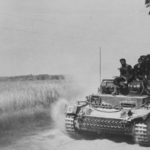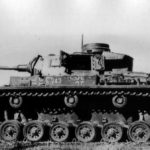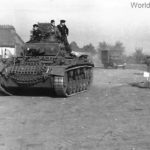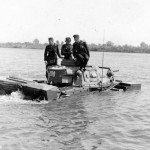Tauchpanzer III at Eastern Front 1941 2
Captured Tauchpanzer III “343” Kubinka 1941, side view
Captured Tauchpanzer III “343” at Kubinka 1941, rear view
Captured Tauchpanzer III “343” on the proving ground in Kubinka
Captured Tauchpanzer III “343” at Kubinka 1941, frontal view
Tauchpanzer III “214” of the Panzer-Regiment 35, 4. Panzer-Division 1941
Destroyed Tauchpanzer III 3
Tauchpanzer III 1941
Tauchpanzer III “213” of the Panzer-Regiment 35, 4. Panzer-Division 1941
TauchPanzer III of the 11. Panzer-Division during Battle of Kiev 41
amphibious tank Tauchpanzer III 100 of the Pz Rgt 18 under test in Putlos
Tauchpanzer III 100 of the Panzer Regimen 18 under test in Putlos
Tank crews atop Tauchpanzer III
Tauchpanzer III 133 fell off the bridge
Tauchpanzer III 523
Tauchpanzer III and panzerman in winter uniform
Tauchpanzer III on city street
Tauchpanzer III and crew color photo
Tauchpanzer III Unternehmen Seelowe
Preparations for Operation Seelowe
Tauchpanzer III
Tauchpanzer III during trials, photo
TauchPanzer III, amphibious tank for Operation Sea Lion
Tauchpanzer III was developed in 1940 for the proposed invasion of Great Britain (Operation Sea Lion – Unternehmen Seelöwe).
The PzKpfw III tanks underwent modifications to equip them with submersion capabilities. The air-intakes were outfitted with locking covers, and non-return valves were installed on the exhaust. To make the cupola, gun mantlet, and hull MG waterproof, fabric covers were fitted. Additionally, an inflatable rubber tube encircled the turret ring. During submersion, the tank would draw air through a pipe from a float carrying a snorkel device and radio antenna that remained on the surface. To navigate underwater, a gyro-compass was utilized. The tank had the ability to operate in depths of up to 15 meters (49.2 feet). To disembark the Tauchpanzer at an appropriate distance from the shore, a vessel with a hinged ramp was used. Following the cancellation of ‘Sea Lion,’ the Tauchpanzer was no longer required in its previous configuration. In the spring of 1941, most of the tanks were modified at Milowitz near Prague to make them suitable for river crossing. A fixed snorkel pipe was attached through the commander’s cupola. From July 1940, four groups of volunteers from existing Panzer regiments received training on the Island of Sylt, and the Tauchpanzer was set to be operational at Putlos by 10 August. In mid-October, three of these groups were assigned to the 18th Panzer Division, and the remainder joined the 6th Panzer Regiment of the 3rd Panzer Division. On 22 June 1941, the Tauchpanzers of the 18th Panzer Division successfully crossed the River Bug at Patulin.
Total production: 168 converted Panzer III Ausführung F,G,H and Panzerbefehlswagen III.






















